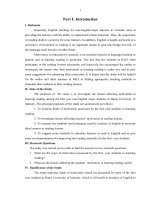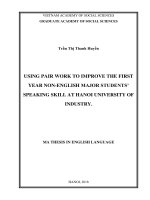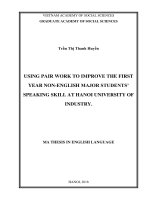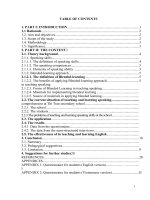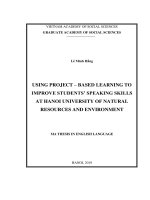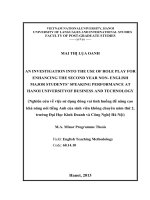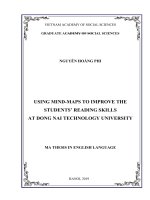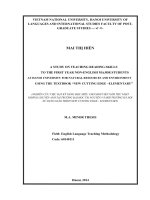USING PROJECT-BASED LEARNING TO IMPROVE STUDENTS’ SPEAKING SKILLS AT HANOI UNIVERSITY OF NATURAL RESOURCES AND ENVIRONMENT
Bạn đang xem bản rút gọn của tài liệu. Xem và tải ngay bản đầy đủ của tài liệu tại đây (685.53 KB, 99 trang )
VIETNAM ACADEMY OF SOCIAL SCIENCES
GRADUATE ACADEMY OF SOCIAL SCIENCES
Lê Minh Hằng
USING PROJECT – BASED LEARNING TO
IMPROVE STUDENTS’ SPEAKING SKILLS
AT HANOI UNIVERSITY OF NATURAL
RESOURCES AND ENVIRONMENT
MA THESIS IN ENGLISH LANGUAGE
HANOI, 2019
VIETNAM ACADEMY OF SOCIAL SCIENCES
GRADUATE ACADEMY OF SOCIAL SCIENCES
Lê Minh Hằng
USING PROJECT-BASED LEARNING TO
IMPROVE STUDENTS’ SPEAKING SKILLS
AT HANOI UNIVERSITY OF NATURAL
RESOURCES AND ENVIRONMENT
Field: English Language
Code: 8220201
Supervisor: Đặng Nguyên Giang, Ph.D.
HANOI, 2019
DECLARATION BY AUTHOR
I hereby sincerely state that the thesis titled “Using Project-Based
Learning to Improve Students’ Speaking Skills at Hanoi University of Natural
Resources and Environment”is the result of my own research for the Degree
of Master of Arts in English Language. The things out of my masterpiece in
this thesis are signed by citation and referred in the references.
Except where reference has been made in the text, this thesis contains
no material previously published or written by another person.The study
reported in this thesis was approved by Graduate Academy of Social
Sciences.
Author’s Signature
Lê Minh Hằng
Approved by
SUPERVISOR
Đặng Nguyên Giang, Ph.D.
Date: …………………………..
i
ACKNOWLEGDEMENTS
Completing this thesis is one of the hardest challenges and the greatest
desires in my life. It was made possible thanks to the encouragement,
assistance and support of many people. First of all, I would like to express my
appreciation and deep gratitude to my supervisor, Dr. Đặng Nguyên Giang
who provided me with valuable advice from my first few days in the course
and through the duration of my thesis to completion. His constructive
suggestion and untiring supervision not only encouraged me to complete my
dissertation, but it helped me effectively develop my research skills as well. In
addition, I am very much grateful to the teachers of Department of Foreign
Languages and the other staff at Graduate Academy of Social Sciences for
granting me the honor of writing this thesis as well as their assistance and
most valuable comments.
Especially, I would like to give sincere thanks to my colleagues at the
Department of English at Hanoi University of Natural Resources and
Environment for their encouragement and attendances during my study. My
appreciation also goes to all twenty eight students at class English3- 27 who
participated in this study for their patient cooperation. Both teachers and
students who have been involved at different stages in this action research
helped provide valuable data so that I have a better views of teaching
speaking at university.
Finally, this study is dedicated to my family for their sympathy and
financial support during my study for M.A degree at Graduate Academy of
Social Sciences. With their love and contribution, I am strongly motivated to
complete this thesis.
ii
TABLE OF CONTENTS
Page
DECLARATION BY AUTHOR
i
ACKNOWLEDGEMENTS
ii
ABSTRACT
vi
LIST OF TABLES
vii
LIST OF FIGURES & CHARTS
viii
LIST OF ABBREVIATIONS
ix
CHAPTER 1: INTRODUCTION
1
1.1. Rationale
1
1.2. Aims of the Study
3
1.3. Research Questions
3
1.4. Scope of the Study
3
1.5. Significance of the Study
4
1.6. Research Methods
5
1.7. Structure of the Study
5
CHAPTER 2: LITERATURE REVIEW
6
2.1. Concepts of Speaking
6
2.1.1. Definitions of Speaking
6
2.1.2. The Nature of Speaking
7
2.1.3. The Components of Speaking
8
2.2. Speaking Teaching
10
2.2.1. Direct and Indirect Method of Teaching Speaking
10
2.2.2. Principles for Techniques in Teaching Speaking
11
2.2.3. Speaking Activities in the Classroom
12
2.3. Project-based Learning
14
iii
2.3.1 Definitions of project-based Learning
14
2.3.2. Types of Projects
15
2.3.3. Evaluation in Project-based Learning
17
2.4. Project-based Learning in English Language Teaching
18
2.4.1. Phases for Implementing a Project-based Learning Projects
Teaching Speaking
18
2.4.2. Teachers’ Roles in Project-based Learning
19
2.4.3. Advantages and Possible Restriction of Project-based Learning
in Teaching English as Foreign Language
20
2.5. Previous Research
23
2.6. Summary
25
CHAPTER 3: METHODOLOGY
26
3.1. Research Setting
26
3.2. Participants
28
3.3. Data Collection Instruments
30
3.4. Research Design
34
3.5. Research Procedures
36
3.6. Data Analysis
39
3.7. Summary
40
CHAPTER 4: FINDINGS AND DISCUSSIONS
41
4.1. Data Analysis from Questionnaires
41
4.2. Data Analysis from Test
51
4.3. Data Analysis from Interviews
55
4.4. Data Analysis from Classroom Observation
61
4.5. Summary
65
CHAPTER 5: CONCLUSION
66
iv
5.1. Recapitulation
66
5.2. Concluding Remarks
68
5.3. Implications
70
5.4. Limitations and Suggestions for Further Studies
71
REFERENCES
73
APPENDIX 1: Scoring Rubic for Speaking Test
I
APPENDIX 2: Pre-test of Speaking
III
APPENDIX 3: Survey questionnaire
IV
APPENDIX 4:PBL survey questionnaire
VI
APPENDIX 5: Post-test of Speaking
IX
APPENDIX 6: Interview questions
X
APPENDIX 7: A Sample of Lesson Plan
v
XI
ABSTRACT
This research tries to attempt to know the effectiveness of Projectbased learning on speaking ability as well as students’perceptions toward the
implementation.The researcher executed action research design at class
English 2-27 with the participation of twenty eight first-year students and cooperation of two teachers as observers at Hanoi University of Natural
Resources and Environment for more than two months. This research applied
an embedded mixed-method design in which the quantitative data were
collected using speaking test, and the qualitative data were collected using
interview, observation checklist and survey questionnaires.The results of the
analysis showed a significant effect of PBL on students’ speaking
competence; additionally, theywere found to have a higher level of
motivation, interest, confidence, creativity and collaborative learning skills in
speaking lessons. Based on the findings, this study recommends the
implementation of PBL in Teaching English as Foreign Language.
vi
LIST OF TABLES
Page
Table 1: Subdivision of Projects according to Outcomes
17
Table 2: The Criteria of Speaking Performance
31
Table 3: Observation Checklist
38
Table 4: Students’ Evaluation of their Achievement on English
49
knowledge
Table 5: Students’ Evaluation of their Achievement on Speaking
49
skills
Table 6: Students’ Evaluation of their Achievement on Learning
49
skills
Table 7: Comparison of Mean Scores between Pre-test and Post-test
52
Table 8: Students’ scores of both tests
53
Table 9: Summary of projects carried out by students
56
vii
LIST OF FIGURES & CHARTS
Page
Chart 1: Students’ willingness in speaking English in class
43
Chart 2: The factors affecting students’ limited performance of
43
speaking skills
Chart 3: Students’ choices of speaking activities
45
Chart 4: Students’ comments on learning environment
46
Chart 5: Students’ opinions of the application of PBL
48
viii
LIST OF ABBREVIATIONS
AR:
Action Research
EFL:
English as Foreign Language
PBL:
Project-Based Learning
HUNRE:
Hanoi
University
of
Natural
Environment
T:
Teacher
Ss:
Students
ix
Resources
and
CHAPTER 1
INTRODUCTION
1.1.
Rationale
In the context of intercultural communication, English is described as
one of the most widely spoken languages in the world, which results in the
continuous shift of demands on learning and acquiring this language in
English non-spoken countries and contributes to the movement of teaching
English as a foreign language. Since Vietnam started to open its door to the
world in 1986, English has increasingly taken an important role and become
an unchangeable mean of keeping up with the pace of the rapidly changing
world. The importance of English was immediately acknowledged by the
Vietnamese government, and as a result, the English language programs
became compulsory with the secondary schools and subsequently the high
schools and finally universities.
The teaching of English in Vietnamese schools has been strongly
focusing on grammar, sentence structures and vocabulary so as to meet
fundamental requirements of evaluation and assessment criterion. In such a
teaching content, conversational English has not come into educators’ focus,
which leads to learners’ limited abilities of communicating with foreigners or
expressing their ideas in a second language. As a result, after at least seven
years learning English in schools, there have been a number of students in
universities facing big challenges from mastering speaking skill. They are
normally found to have several problems in oral activities, such as reluctance,
fluency, shyness or fear of committing mistakes.
The reality shows that most of the students at Hanoi University of
Natural Resources and Environment (HUNRE) find it challenging in
communicating well orally. From what students have displayed in their oral
1
performances in the classes and their results in latest final tests, a large
number of students are not able to describe their personalities or even their
daily activities in English. Their abilities of mastering speaking skill are
normally highly complained by the teachers not just about pronunciation,
vocabulary, grammar accuracy but fluency level, gesture improving and
communicative competence as well. To deal with this challenge, language
teachers need to employ appropriate English teaching and learning methods
that may encourage the students to use language with an emphasis on
communicative purposes in real world settings, rather than completely focus
on grammatical accuracy as in traditional teaching.
It is stated that speaking is an interactive process of constructing
meaning that involves producing, receiving and processing information
(Brown, 1994; Burns & Joyce, 1997 as stated in Flowrez (1999)). It requires
great amount of exercise and practice, otherwise the students’ speaking
cannot be improved. In addition, Brown (1994) states that anxiety is one of
problems faced by the students in speaking because they are afraid to be
judged as stupid and incomprehensible people. Therefore, a linguistic teacher
needs to create safe learning environment so that the students feel comfortable
and confident enough to get themselves involved in classroom oral activities.
Blumenfeld (1991) said that project-based learning (PBL) seemed to
match this English teaching and learning needs, especially the benefits of
learning by practice. The PBL technique refers to a method allowing to do the
designing, planning and carrying out tasks in order to produce, publish and
present a product. Throughout the PBL technique, learners are encouraged to
complete authentic activities (project-work), so that they have the opportunity
to use the language in a relatively natural context and participate in
2
meaningful activities which require authentic use of English as a Foreign
Language (EFL) language kill.
Throughout this classroom action research, the researcher tries to
experiment and adapt PBL techniques on teaching English speaking skills for
the non-major first-year students so that a solution may be then tohelp them
be more motivated and interested in speaking. Accordingly, the researcher
decides to examine how well project-based learning impact the students’
speaking skills.
1.2.
Aim(s) of the Study
The aim of the study is to improve the first-year students’ English
speaking skill at HUNRE.
In order to achieve the aim, the study is expected to reach the following
objectives:
- Investigating the first-year students’ attitudes towards the projectbased learning techniques used in their speaking periods.
-
Evaluating the effectiveness of the
project-based learning
techniquesapplied to English speaking skill teaching and learning.
1.3.
Research Questions
The objectives of the study can be elaborated into the research
questions as follows:
- How do the project-based learning promote the first year students’
motivation?
- To what extent, do the project-based learning increase the first year
students’ speaking outcome?
1.4.
Scope of the Study
In this study, the researcher focally identifies the effectiveness of
employing the project-based learning techniques on improving non-major first
3
year students’ speaking skills as well as their attitudes towards oral activities.
There will be twenty-eight students at elementary level participating in this
action research. They are expected to have basic knowledge of English about
grammar, acceptable ranges of vocabulary; or limited but effective command
of the language in familiar situations such as family topics and lifestyle
expression. They may have studied English through years of secondary and
high school, but not have had much opportunity to practice speaking English.
They are selected to take part in this investigation to check how well their
background of English and potential abilities of speaking can be activated and
improved after PBL is applied in their speaking lessons.
1.5.
Significance of the Study
Theoretically, this study is expected to make a contribution to
development in teaching speaking at HUNRE so as to get more achievement
not just in methodology but in further development of English Department as
well. In addition, the research findings will partly enrich the previous theories
and research on EFL teaching and learning, especially in teaching English
speaking skill.
Practically, it is highly hopeful that the results of the study can provide
the teachers of English at HUNRE with a good alternative way for teaching
speaking skill, which can attract student’s attention and get them more
interested in the lessons. In the terms of students, they are the main subject to
take potential benefits of learning from PBL which helps them enhance not
only their working skills (individually, pair work or team work), but also
skills of planning, critical thing and creativity ability. Specifically, their needs
of learning English is hoped to be fulfilled. They can build their projects to
suit their own interests and abilities. Furthermore, learners can increase in
4
problem-solving skills, meaning that they are able to identify the topics and
their problems, then seek possible solutions.
1.6.
Research Methods
In order to achieve the aim, action research procedures are used in the
present study. In schools, action research (AR) refers to a process of
evaluation, investigation, and analysis designed to diagnose problems or
weaknesses – whether organizational, academic, or instructional – and help
educators develop practical solutions to address them quickly and
efficiently.The data were collected via survey questionnaires, classroom
observations, interviews, and oral tests.
1.7.
Structure of the Study
This research is organized in the following manner. The first chapter
gives reasons for choosing the thesis, scopes and aims of the study as well as
the research methods. Chapter two begins the journey with an overview of the
literature by providing the theoretical foundations, defining project-based
learning in relationship to several other similar approaches, and also discusses
previous studies in the area. Chapter three gives the specific description of the
methodology, which includes research setting, participants, data collection
instruments, research design, research procedures and data analysis. Chapter
four discusses the analysis and results from the data which are divided into
four main sections, reflecting the different types of data present in the study.
Chapter five concludes with a discussion of the findings of the study and its
implications for second language teaching theory and practice. Last but not
least, the limitations of the study and directions for future research are also
concluded.
5
CHAPTER 2
LITERATURE REVIEW
2.1. Concepts of Speaking
2.1.1. Definitions of speaking
Speaking is a kind of communicative and interactive activity between
people in which information is continuously produced, received and
processed so that the participants are able to converse and express their
thoughts and feelings. The form and meaning of information are dependent on
the context in which it occurs including the physical environment, the purpose
of conversation and the collective experience of the participants (Burns &
Joyce, 1997). It is supported by Byrne (1984), in this oral activity, both the
speakers and the listeners have positive function in deciding success and
failure of this communication process. The speakers are responsible for
creating a clear message that will be understood and responded by the
listeners. A speaker must be able to anticipate and then produce the expected
patterns of specific discourse situation. For example, when a salesman asks
“How can I help you?”, the expected discourse sequence includes a statement
of need, an offer of appreciation and a leave-taking exchange. In order to give
the correct response, a learner must understand the setting in which the speech
act occurs, choose the correct vocabulary to describe the item sought,
rephrase or emphasize words to clarify the description if the clerk does not
understand.
Therefore, as Brown (1994) states that in order to communicate
successfully, a speaker needs to develop both linguistic competence and
sociolinguistic competence at the same time. It means that speaking requires
learners not only know how to produce specific points of language such as
6
grammar, pronunciation, or vocabulary, but also that they understand when,
why and in what ways to produce language.
Based on the definitions above, it can be conducted that learning to
speak involves “developing a number of complex skill and different types of
knowledge about when and how to communicate” (Brown, 1994). As a result,
in speaking lessons, teachers should monitor learners’ speech production to
determine what skills and knowledge they already have and what areas need
development.
2.1.2. The nature of speaking
Brown (2004) states that speaking is a productive skill that can be
directly and empirically observed, “those observations are invariably colored
by the accuracy and effectiveness of a test taker’s listening skill, which
necessarily compromises the interaction between teacher and students or
among the students which depends on how classroom activities are
organized”. He further states that there are some basic types of speaking as in
the following:
a. Imitative: this type of speaking refers to the ability of imitating a word,
a phrase or a sentence. The purely phonetic level of oral production, a
number of lexical and grammatical properties of language may be
included in the criterion performance.
b. Intensive: The production of short stretches of oral language is
designed to demonstrate competence in a narrow band of grammatical,
phrasal, lexical or phonological relationship.
c. Responsive: This type include interaction and test comprehension but at
the somewhat limited level of very short conversations, standard
greetings and small talk, simple requests and comments.
7
d. Interactive: The difference between responsive and interactive speaking
is in the length and complexity of the interaction, which sometimes
includes multiple exchanges or multiple participants. Interaction can
take the two forms of transactional language, which has the purpose of
exchanging specific information or interpersonal exchanges which have
the purpose of maintaining social relationship.
e. Extensive: extensive oral production tasks include speeches, oral
representation and storytelling, during which the opportunity for oral
interaction from listeners is either highly limited or ruled out together.
2.1.3. The components of speaking skill
According to Vanderkevent (1990), there are three components in
speaking, including: the speakers, the listeners and the utterances. Speakers
are people who produce the sound, they are useful as the tool to express
opinion or feelings to the hearer. Therefore, if there are no speaker, the
opinion or the feelings will not be stated. On the other hand, listeners are
people who receive or get the speakers’ opinion or feeling. If there are no
listeners, speaker will mostly express their opinion by writing. Last but not
least, the utterances are words or sentences produced by the speakers to state
the opinions and feelings
As proposed by Brown (1994), speaking is not simply expressing
something orally, it asks language learners to acquire some aspects of oral
performance so that they can improve their speaking competence. Those
aspects consist of pronunciation, fluency, vocabulary and accuracy (Harris,
1974)
a. Pronunciation:
Pronunciation refers to the students’ ability to produce clear language to
fulfill the task requirements. It becomes important because it gives
8
meaning to what is being said. Therefore, to make a successful
communication happen, clear messages need to be delivered for listeners.
Wrong pronunciation may cause misunderstanding or people involved in
a conversation are offended. In speaking, teaching pronunciation includes
stress, rhythm and intonation.
b. Fluency
It is pointed out that a fluent speaker is a person who can express a
sequence of ideas easily, smoothly and expressively. In a language
classroom, speaking activities which focus on fluency require students to
get things done smoothly through conversation, with a few acceptable
infrequent pauses. Harris proposes a model in assessing speaking in
which fluency is measured by considering the total number of seconds of
silence and time spent saying “uhm”, “ah” by subjects as they complete a
task.
c. Grammar
“Grammar is the system of rules governing the conventional arrangement
and relationship of words in a sentence” (Harris, 1974), so it is needed for
students to build up a correct sentence in conversation. If there are too full
of grammar mistakes during a dialogue, the communication will be
certainly slowed down.
d. Vocabulary
Vocabulary is a set of lexemes, consisting single words, compound words
and idioms that are typically used when talking something. To be able to
speak fluently and accurately, learners should master enough vocabulary
and has capability to use it accurately.
e. Comprehension
9
This component of speaking is an ability to perceive and process stretches
of discourse. In other meaning, it refers to the speakers’ understanding
about what they are saying to the listeners so as to avoid
misunderstanding information; in addition, its function is to make the
listeners easily to catch the information from the speakers.
2.2. Speaking Teaching
2.2.1. Direct and Indirect methods of teaching speaking
The mastery of speaking skills in English is a priority for many second
or foreign language learners. They consequently often evaluate their success
in learning on the basis of how well they have improved in their spoken
language proficiency. In speaking, speakers tend to be getting something
done, exploring ideas, working out some aspect of the world, or simply being
together. In learning a foreign language, a lack of automaticity, grammatical
knowledge, and lexical knowledge influence a lack of foreign language
fluency(Thornburry, 2005). Therefore, it needs appropriate methods in
teaching and teachers are highly expected to apply a variety of approaches,
ranging from direct approaches focusing on specific features of oral
interaction (turn-taking, topic management, questioning strategies) to indirect
ones which create conditions or give learners a real – life context for verbal
communication through group work, task work and other strategies (Richards,
1990).
It is maintained that a direct approach focuses on “the development of
isolated speaking skills, micro-skills” (Thornbury, 2005) and concerns with “a
structural accuracy and emphasizes the use of language forms”. It also
“provides space for language analysis, raising learners’ awareness about
grammar, discourse structures, and routines” (the components of language).
An indirect approach, on the other hand, focuses on the development of
10
fluency of speech. It “encourages learners to use language by engaging them
in communicative activities” (Goh& Burns, 2012). Learners are believed to
acquire speaking skills by communicating with each other and they will be
able to transfer those skills to real-life situation.However, Goh and Burns
(2012) point that both direct and indirect approaches have their own
limitations. As the focus of the first one is on using language to complete a
task, rather than on practicing language; the latter tend to neglect the
development of accuracy”. Therefore, in order to master speaking skills, a
combination of features in both approaches should be emphasized.
All in all, the aim of teaching speaking is to train students for more
effective interaction with people in real life. The teacher teaches speaking by
carrying out the students in certain situation when the topic is being talked
about so that students can develop their ideas and have an oral command of
the language need to describe the topic.
2.2.2. Principles for Techniques in Teaching Speaking
Brown (2001) assumes that there are some principles for techniques in
teaching speaking:
First of all, teachers can employ techniques that cover the spectrum of
students’ needs, from language-based focus on accuracy to messagebased focus on interaction, meaning and fluency.
Secondly, the techniques should provide intrinsically motivating
techniques, in which students must understand how the techniques and
activities will have advantages to them.
Thirdly, the techniques might improve the use of authentic language in
meaningful context. They may need efforts to devise authentic contexts
and meaningful interaction; or teachers can find from resource
materials.
11
Fourthly, conducting feedback and correction is the next principle for
the technique in teaching speaking. It is important to teachers to adopt
the kinds of corrective feedback which are appropriate for the moment
(Brown, 2001)
Fifthly, the techniques must combine the speaking and listening skill.
These two skills can reinforce each other, skills in producing language
are often taught through comprehension.
Finally, the techniques have to encourage the development of speaking
strategies. Students can be aware of and have an opportunity to practice
some strategies like asking for clarification, asking someone to repeat
something, using nonverbal expression.
2.2.3. Speaking Activities in the Classroom
If we assume that speaking the FL is an essential part of language
learning, teachersmustprovide activities that involve interaction between
learners. Scrievener (2005)makes the important point that “the aim of the
communicative activity in class is to get learners to use the language they are
learning to interact in realistic and meaningful ways, usually involving
exchanges of information or opinion.” Among these activities are the
following:
Communication games: teachers design such games to encourage and
involve the students in a verbal interaction. O‟Malley and Pierce
(1996) call these activities “information gap activities”; they define
them as “the ability of one person to give information to another. An
information gap is an activity where one student is provided with
information that is kept from a partner.”
Drama, simulations and role-plays: These three types of oral
activities are very important. O‟Malley and Pierce (1996) say that such
12
activities are more authentic because they provide a format for using
the real life conversation such as repetitions, interruptions, recitations,
facial expressions and gestures.
Students often engage in another
identity in role-plays, drama and simulations activities, where their
anxiety is reduced, their motivation is increased and their language
acquisition is enhanced.
Discussion activities: these activities are often employed for advanced
language learners; they can serve as the basis of spontaneous
interaction. Lindsay and Knight (2006) point out that in such activities,
students are supposed to give their opinions or receive others' opinions.
They can speak freely without being told what to say or not by the
teacher. The students should be only informed of what to talk about and
given enough time to structure what they wish to say. However,
Thornbury (2005) says that many teachers agree that the best
discussions are those that arise spontaneously either because one
learner reports something personal or because the topic of the course
book arises discussion.
Presentations and Talks: The best way to make students gain their
self-confidence is through making them present oral works in front of
their classmates. Thornbury (2005) asserts that the students act of
standing up in front of their colleagues and speaking is an excellent
preparation for authentic speaking. A prepared talk is when students
make the presentation on a given topic of their choice, and this talk is
not planned for informal spontaneous conversations; it is more writinglike.
2.3. Project-Based Learning
2.3.1. Definitions of Project-based learning
13
The foundations of project-based learning approach are rooted in
Dewey, dating back to the early 20th century. He strove to advocate for
project-based learning as one of the most inspiring and sustainable
educational approach, which is believed that the classroom should be a
reflection of society and students should be active learners, rather than
passively receive information from teachers ( via Eyring, 2001). According to
Brydon& Miller (2006), teaching based on project based approach is “a
largely uni-directional system in which the teacher deposits learning into the
empty vessels who are students, later withdrawing this learning in the form of
testing. Standardized tests are thus ultimate form of narrow-minded
accountancy in the banking approach to education”.
Thomas (2000) stated that Project – based learning is a kind of a
student-centered pedagogy in which students learn about the target language
through the experience of problem-solving and then, produce the outcomes
that might be in form of presentation, exhibition, publication, etc.
Legutke& Thomas (1991) defined PBL as an “educational philosophy
which aims at providing the direction, and some possible routes, to a more
democratic and participatory society”. In order to make it further clarified,
several key characteristics of PBL generally agreed upon by Legutke&
Thomas are summarized in the following points:
1. Themes and target tasks derive from “life”
2. The educational value of project learning is fostered through the
process of discussion, experimentation, reflection, and application.
3. Project learning is investigative and follows a cyclical model of
experiential learning.
4. Project learning is learner-centered and allows learners to discover
their specific strengths, interests and talents.
14
